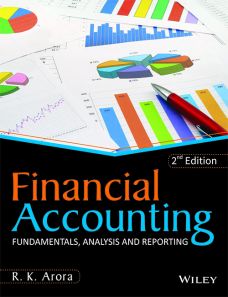Financial Accounting, 2ed: Fundamentals, Analysis and Reporting
ISBN: 9788126575701
552 pages
Publication Year: 2018
For more information write to us at: acadmktg@wiley.com

Description
The book Financial Accounting – Fundamentals, Analysis and Reporting takes the students through the subject matter of Financial Accounting in a step-wise manner. Chapter 1 provides the basics of accounting and its uses. Chapters 2 and 3 introduce the financial statements prepared by business enterprises. Chapters 4 to 9 and Chapter 11 then explain the detailed process of preparing simple and intricate financial statements of both noncorporate and corporate entities, including banking companies. After this, the analysis of the financial statements from the perspective of managerial decision making is explained in Chapter 12.
Preface
About the Author
1 Nature and Purpose of Accounting
1.1 Introduction
1.2 Accounting
1.3 Users and Uses of Accounting Information
1.4 Sub-Fields of Accounting
1.5 Accounting Terms
1.6 Financial Statements
1.7 Generally Accepted Accounting Principles
2 Balance Sheet
2.1 Introduction
2.2 Balance Sheet
2.3 Assets
2.4 Liabilities
2.5 Basic Concepts Underlying Preparation of Balance Sheet
3 Statement of Profit and Loss
3.1 Introduction
3.2 Statement of Profit and Loss
3.3 Basic Concepts
4 Accounting Records and Systems
4.1 Introduction
4.2 Steps in the Accounting Cycle
4.3 Analysis of Accounting Transactions
4.4 Accounting Records
4.5 Trial Balance
5 Preparation of Financial Statements
5.1 Introduction
5.2 Relationship Between Profit and Loss Account and Balance Sheet
5.3 Preparation of Profit and Loss Account
5.4 Preparation of Balance Sheet
5.5 Adjustment Entries
5.6 Adjusted Trial Balance
6 Plant Assets and Intangible Assets
6.1 Introduction
6.2 Accounting for Property, Plant and Equipment
6.3 Revaluation of Property, Plant and Equipment
6.4 Retirements and Disposals
6.5 Depreciation
6.6 Depreciation Methods
6.7 Impairment of Assets
6.8 Intangible Assets
6.9 Internally Generated Intangible Assets
6.10 Amortization of Intangible Assets
6.11 Useful Life of Intangible Assets
6.12 Residual Value of Intangible Assets
6.13 Research and Development Expenditure
6.14 Goodwill
7 Inventories: Accounting and Valuation
7.1 Introduction
7.2 Inventories
7.3 Reasons for Keeping Inventories
7.4 Objectives of Inventory Accounting
7.5 Effects of Inventory Misstatements
7.6 Systems for Keeping Inventory Records
7.7 Cost of Inventories
7.8 Inventory Costing Methods
7.9 Inventory Costing Under the Periodic Inventory System
7.10 Inventory Costing Under the Perpetual Inventory System
7.11 Comparison of Alternative Inventory Costing Methods
7.12 The Consistency Principle
7.13 Lower-of-Cost or Market Value
7.14 Determining Inventory Quantities
7.15 Valuing Inventories by Estimation
7.16 Recognition of Inventories as an Expense
7.17 Disclosure
8 Corporate Financial Statements
8.1 Introduction
8.2 Books of Accounts to Be Kept by a Company
8.3 Financial Statements
8.4 Assets
8.5 Equity
8.6 Other Equity
8.7 Liabilities
8.8 Contingent Liabilities and Commitments
8.9 Revenue from Operations
8.10 Other Income
8.11 Expenses
8.12 Profit Before Exceptional Items and Tax
8.13 Exceptional Items
8.14 Tax Expense
8.15 Profit (Loss) for the Period from Continuing Operations
8.16 Discontinued Operations
8.17 Profit (Loss) for the Period
8.18 Other Comprehensive Income
8.19 Earnings per Share
8.20 Income Taxes
8.21 Dividend
8.22 Preliminary Expenses
8.23 Discount on Issue of Shares or Debentures
8.24 Capitalization of Profits
8.25 Preparing Profit and Loss Account and Balance Sheet
9 Financial Statements of Banking Companies
9.1 Introduction
9.2 Types of Banks
9.3 Accounting System of Banks
9.4 Legal Provisions
9.5 Income Recognition
9.6 Format of Financial Statements
9.7 Classification of Advances and Provisioning
9.8 Classification of Investments
9.9 Capital Adequacy Norms
9.10 Some Special Transactions
10 Understanding Corporate Annual Reports
10.1 Introduction
10.2 Notes to Accounts
10.3 Directors’ Report
10.4 Independent Auditors’ Report
10.5 Segment Information
10.6 Related Party Transactions
10.7 Corporate Governance Report
10.8 Management Discussion and Analysis Report
10.9 Business Responsibility Report
10.10 Value Added Statement
10.11 Economic Value Added Statement 398
11 Statement of Cash Flows
11.1 Introduction
11.2 Cash and Cash Equivalents
11.3 Purposes of Cash Flow Statement
11.4 Operating Activities
11.5 Investing Activities
11.6 Financing Activities
11.7 Reporting Cash Flows from Operating Activities
11.8 Reporting Cash Flows from Investing Activities
11.9 Reporting Cash Flows from Financing Activities
11.10 Treatment of Special Items
11.11 Format of Cash Flow Statement (Direct Method) 414
11.12 Format of Cash Flow Statement (Indirect Method)
11.13 Analysis of Cash Flow Statement
12 Analysis of Financial Statements
12.1 Introduction
12.2 Techniques of Financial Analysis
12.3 Comparative Financial Statements
12.4 Trend Percentages
12.5 Common-Size Financial Statements
12.6 Ratio Analysis
12.7 Analyzing Financial Statements of Banking Companies
12.8 Quality of Earnings
12.9 Sustainable Income
13 Financial Reporting Standards
13.1 Introduction
13.2 Accounting Standards Issued by ICAI
13.3 International Financial Reporting Standards (IFRS)
13.4 Advantages of Adopting IFRS
13.5 Indian Accounting Standards
13.6 Applicability and Roadmap for Implementation of Ind AS
13.7 Comparison of Indian GAAP, IFRS and Ind AS
Summary – Review of Learning Objectives
Glossary
Review Questions
Index

